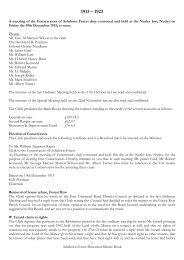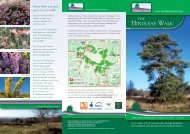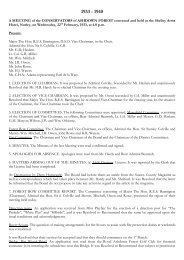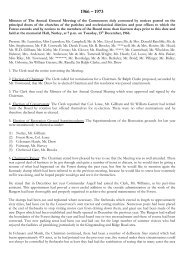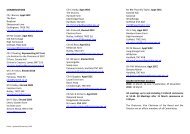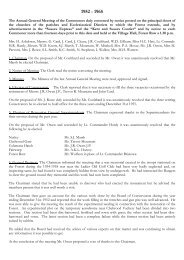AF_Legal_Summary_Jul.. - Ashdown Forest
AF_Legal_Summary_Jul.. - Ashdown Forest
AF_Legal_Summary_Jul.. - Ashdown Forest
Create successful ePaper yourself
Turn your PDF publications into a flip-book with our unique Google optimized e-Paper software.
LEGISLATION AND GOVERNMENT POLICY RELEVANT TO ASHDOWN FOREST<br />
Notes for the Board of Conservators of <strong>Ashdown</strong> <strong>Forest</strong><br />
Prepared by Philip Glyn, June 2007, revised November 2008, August 2009 and June 2011<br />
BACKGROUND TO THE DOCUMENT<br />
<strong>Ashdown</strong> <strong>Forest</strong> has a long and complicated history of land ownership, usage and relevant legislation. This document<br />
lists and summarises the major historical and modern legal instruments that protect or regulate land managed by the<br />
Conservators and those who use it. It is written by a non-lawyer to provide sources of reference material for those who<br />
wish to discover more about the position in 2011. It is believed to be accurate and reasonably comprehensive but is<br />
confined to law or policy particularly relevant to <strong>AF</strong> issues (eg it does not look at The Protection of Badgers Act 1992) and<br />
the author would welcome any information on errors or substantial omissions. Throughout the document, <strong>Ashdown</strong><br />
<strong>Forest</strong> is referred to as ‘the <strong>Forest</strong>’ or ‘<strong>AF</strong>’. Web sources were current at <strong>Jul</strong>y 2011 and are underlined in blue - like this.<br />
Clicking on them should open the web link. The <strong>AF</strong> website is being revised and links here to it may soon change.<br />
Relevant legislation falls into two major categories, British law and EU law:<br />
The former category consists of Acts of Parliament (for example, The Commons Act 2000) and relevant Schedules and<br />
also Regulations (for example the Conservation (Natural Habitats, & c.) Regulations 1994).<br />
The latter comprises Directives originating from the Council of the European Union (not to be confused with the European<br />
Council or the Council of Europe) consisting of Articles and Annexes (for example, Council Directive 79/409/EEC). EU<br />
Directives are encapsulated into GB law by means of Statutory Instruments (Regulations).<br />
Both categories cover matters ranging from public access and governance to protection of endangered wildlife; UK law<br />
listed here deals with governance matters as well as the implementation of European Council Directives. Policy<br />
documents on UK wildlife matters are provided by Statutory Bodies, eg Natural England.<br />
Matters of potential conflict between different pieces of legislation are likely to need detailed legal scrutiny for clarification<br />
and are outside the scope of this document. Sources are quoted as published documents or Web links. UK Public Acts<br />
from 1988 and Local Acts from 1991 are available at http://www.opsi.gov.uk/acts.htm#acts with some older PDF scanned<br />
material.Legislation made before 1988 is available in its original print format, see http://www.tso.co.uk/ or HMSO.<br />
Historical background of <strong>Ashdown</strong> <strong>Forest</strong><br />
The following 1830-2006 extracts are taken from the <strong>AF</strong> website summary of <strong>Ashdown</strong> <strong>Forest</strong> legislation and<br />
organisational history. http://www.ashdownforest.org/history/history_1700_2000.php<br />
1830 - Formation of a committee of four Commoners, a nominee of the Lord of the Manor and four employed Lookers to<br />
enforce regulation.<br />
1875 - Lord De La Warr and his steward challenged whether or not the Commoners had any rights other than estovers and<br />
“herbage by bite of mouth”.<br />
1878 - Action brought by the Earl against Commoner Bernard Hale, Deputy Lieutenant of Sussex and East Grinstead<br />
Magistrate. The Earl won. William Augustus Raper, a Hastings solicitor, was responsible for accumulating much of the<br />
evidence on behalf of the Commoners.<br />
1881 - The appeal failed to establish a right of common for Hale, but did allow that he had a Right by Usage (i.e. a<br />
Prescriptive Right). In an attempt to protect the rights of all the Commoners, the committee prepared a case against the<br />
Earl. He capitulated and under the Common Lands Regulation (<strong>Ashdown</strong> <strong>Forest</strong>)Provisional Order Confirmation Act of<br />
1885, a Board of Conservators was appointed with powers to regulate the common land usage.<br />
1937 - <strong>Ashdown</strong> <strong>Forest</strong> Act strengthened the powers of the Conservators to enforce the new byelaws drawn up in 1935,<br />
especially in respect of digging up plants and litter cutting. It arranged for grants from local authorities in exchange for<br />
representation on the Board.<br />
1949 - further <strong>Ashdown</strong> <strong>Forest</strong> Act formalised and regulated the use of the <strong>Forest</strong> for army training.<br />
1961 - Formation of the Society of Friends of <strong>Ashdown</strong> <strong>Forest</strong>.<br />
<strong>AF</strong> legal rev <strong>Jul</strong>y 2011 Page 1 of 9
1974 - Most recent <strong>Ashdown</strong> <strong>Forest</strong> Act.<br />
1988 - Purchase of the <strong>Forest</strong> from Earl De La Warr by East Sussex County Council.<br />
1994 - Purchase of sixty-nine acres of woodland at Chelwood Vachery.<br />
1996 - <strong>Forest</strong> designated a Special Protection Area, further conserving the bird life.<br />
1996-1998 - Phased fencing and re-introduction of grazing to 1300 acres on the south/west chases.<br />
2001 - <strong>Forest</strong> designated a Special Area of Conservation to help conserve vulnerable habitats. <strong>Forest</strong> entirely closed for<br />
six weeks due to Foot and Mouth Disease precautions.<br />
2006 – August; HLS agreement signed<br />
.....................................................................................................................................................<br />
The following paragraphs list chronologically and provide notes on Acts of Parliament, EU directives and government<br />
policy that are believed to have a bearing on <strong>Ashdown</strong> <strong>Forest</strong>:<br />
Commons Act 1876<br />
This set out the provision for inclosure (sic) under the Inclosure Acts 1845 to 1868, whereby the Inclosure Commissioners<br />
may, by provisional order, authorise the inclosure of a common, provided they were satisfied that, among other things, the<br />
public interest was protected, and provided they had regard to ‘the benefit of the neighbourhood’.<br />
36 commons in England and Wales are or were regulated under the Commons Act 1876. The Act enabled commons to be<br />
regulated or inclosed (sic) by means of an Order that generally provided for management to be assigned to a Board of<br />
Conservators, twenty or more Boards remain today.<br />
.....................................................................................................................................................<br />
<strong>Ashdown</strong> <strong>Forest</strong> Act 1885 - the full title is the ‘Common Lands Regulation (<strong>Ashdown</strong> <strong>Forest</strong>) Provisional Order<br />
Confirmation Act of 1885'<br />
This Act established a Board of Conservators viz. 12 elected Commoners plus a representative of the Lord of the Manor<br />
(Earl De La Warr). It provided the power to make and oversee <strong>Forest</strong> bye-laws, protect the rights of and regulate the<br />
numbers and activities of Commoners and preserve the <strong>Forest</strong> in its natural state. Many small, previously illegal,<br />
enclosures were recognized.<br />
The three subsequent <strong>Ashdown</strong> <strong>Forest</strong> Acts of 1937, 1949 and 1974 further strengthened the powers of the Conservators to<br />
enforce new bye-laws, formalised and regulated the use of the <strong>Forest</strong> for army training and arranged for grants from local<br />
authorities in exchange for representation on the Board.<br />
http://www.ashdownforest.org/history/history_1700_2000.php<br />
In 1893 the Law of Commons Amendment Act was passed. This was designed to prevent owners of common land<br />
circumventing the 1876 act by reliance on the Statute of Merton (the Commons Act 1236) which allowed them to inclose<br />
the common provided that they left a sufficiency for the freehold tenants.<br />
http://www.opsi.gov.uk/RevisedStatutes/Acts/ukpga/1893/cukpga_18930057_en_1<br />
.....................................................................................................................................................<br />
<strong>AF</strong> legal rev <strong>Jul</strong>y 2011 Page 2 of 9
Commons Act 1899<br />
This enabled District Councils to manage commons where their use for exercise and recreation was the prime<br />
consideration and where the owner and commoners do not require a direct voice in the management, or where the owner<br />
cannot be found.<br />
.....................................................................................................................................................<br />
National Parks and Access to the Countryside Act 1949<br />
This Act gave powers to Natural England (then called the Nature Conservancy) to designate Sites of Special Scientific<br />
Interest (SSSIs) and National Nature Reserves (NNRs), and to local authorities to designate Local Nature Reserves<br />
(LNRs).<br />
http://www.opsi.gov.uk/RevisedStatutes/Acts/ukpga/1949/cukpga_19490097_en_1<br />
<strong>Ashdown</strong> <strong>Forest</strong> reasons for notification: http://www.sssi.naturalengland.org.uk/citation/citation_photo/1001983.pdf<br />
.....................................................................................................................................................<br />
The Commons Registration Act 1965<br />
The registration authorities' duties and responsibilities were set out in the 1965 Act, and in regulations made under the<br />
Act. These responsibilities are replaced by those set out in Part I of the Commons Act 2006.<br />
http://www.opsi.gov.uk/RevisedStatutes/Acts/ukpga/1965/cukpga_19650064_en_1<br />
.....................................................................................................................................................<br />
Countryside Act 1968<br />
The 1968 Act empowered the Secretary of State to make grants to local authorities for Country Parks and amended the<br />
1949 Act to allow grants payable under that Act to be dealt with in the same way as grants made under the 1968 Act. The<br />
memorandum set out the terms and conditions for payments under the two Acts in respect of expenditure on the<br />
following: National Parks land and areas of outstanding natural beauty; the establishment of country parks and facilities<br />
therein; the countryside generally (including the above) and long distance routes.<br />
http://www.opsi.gov.uk/RevisedStatutes/Acts/ukpga/1968/cukpga_19680041_en_1<br />
.....................................................................................................................................................<br />
Local Government Act 1972<br />
This Act reformed the organisation of local government, including ESCC. It laid down standing orders for regulating<br />
Council procedures.<br />
http://opsi.gov.uk/RevisedStatutes/Acts/ukpga/1972/cukpga_19720070_en_1<br />
.....................................................................................................................................................<br />
<strong>Ashdown</strong> <strong>Forest</strong> Act 1974<br />
This is the most recent legislation specifically about <strong>Ashdown</strong> <strong>Forest</strong> that covers its finance and the duties of its Board of<br />
Conservators. All Board members are provided with a printed copy of this but the lines below highlight major points.<br />
Section references are in brackets.<br />
http://www.ashdownforest.org/docs/<strong>Ashdown</strong>_<strong>Forest</strong>_Act%201974.pdf<br />
(15) The Clerk ... shall prepare and keep a register of the commoners ...<br />
(16) It shall be the duty of the Conservators at all times as far as possible to regulate and manage the <strong>Forest</strong> as an amenity<br />
and place of resort subject to the existing rights of common and to protect such rights of common, to protect the forest<br />
from encroachments and to conserve it as a quiet and natural area of outstanding beauty.<br />
<strong>AF</strong> legal rev <strong>Jul</strong>y 2011 Page 3 of 9
(17) The Conservators have the power to:<br />
subject to the consent of the lord of the manor .... engage in all manner of tree conservation, including planting, felling<br />
cutting and lopping of trees and shrubs...<br />
protect any part of the forest and ... erect fences therefor;<br />
conserve the fauna and flora and ... improve grazing;<br />
conserve those parts of the forest which are of historical, archaeological and physiographical interest;<br />
provide and maintain vehicles, plant ... and buildings ...;<br />
provide and maintain recreational facilities which ... do not involve the erection of new buildings ... of any kind ...;<br />
make, provide, maintain and extend car parking places for vehicles ....;<br />
appoint officers and staff for the purpose of more efficiently and properly carrying out the duties of the Conservators...;<br />
(20) The Conservators may acquire by agreement ... purchase, exchange, lease, gift or otherwise any land within or outside<br />
the forest, and hold such land as part of the <strong>Forest</strong>...<br />
... sell ... let or mortgage any land held by them.<br />
(21) ...the public shall have access on foot to the <strong>Forest</strong> for quiet recreation and enjoyment.<br />
(24 and 25) East Sussex County Council and Wealden District Council should meet the expenses of the Conservators in so<br />
far as such expenses are not defrayed by the proceeds of the rate levied on the Commoners and out of other income.<br />
Section 19 of the Act allows the Conservators to ‘make, alter or repeal byelaws for the regulation and better administration<br />
of the forest’.<br />
.....................................................................................................................................................<br />
East Sussex Act 1981<br />
Section 89 of this lengthy Act, covering many procedural matters in the County administration, replaces the option of<br />
proxy vote for election of <strong>AF</strong> conservators with postal votes.<br />
.....................................................................................................................................................<br />
The Wildlife and Countryside Act 1981<br />
This is still the major legal instrument for wildlife protection in Britain, although other significant Acts have been passed<br />
since. It has numerous parts and supplementary lists and schedules many of which have been amended since publication;<br />
it was amended in 1985 and 1991 and schedules amended 1988, 1991, 1992 and 1998. It is therefore often referred to as<br />
‘The Wildlife and Countryside Act 1981 (as amended)’.<br />
This legislation is the means by which the Convention on the Conservation of European Wildlife and Natural Habitats (the<br />
'Bern Convention') and the European Union Directives on the Conservation of Wild Birds (79/409/EEC) and Natural<br />
Habitats and Wild Fauna and Flora (92/43/FFC) (see below) are implemented in Great Britain see Statutory<br />
Instrument 1994 No. 2716 below.<br />
* Part I is concerned with the protection of wild plants and animals<br />
* Part II relates to the countryside and national parks (and the designation of protected areas),<br />
* Part III covers public rights of way,<br />
* Part IV deals with miscellaneous provisions of the Act ie prevention of release of non-native plants or animals<br />
Section 28G of the Wildlife and Countryside Act (as amended by the Countryside and Rights of Way Act) requires a local<br />
authority to “take reasonable steps, consistent with the proper exercise of the authority’s functions, to further the<br />
conservation and enhancement of the flora, fauna or geological or physiographical features by reason of which the site is<br />
of special scientific interest”. And “The Secretary of State expects that all public bodies will take full account of their<br />
responsibilities under this duty whenever their actions may affect SSSIs”.<br />
http://www.jncc.gov.uk/page-1377<br />
http://www.uk-legislation.hmso.gov.uk/RevisedStatutes/Acts/ukpga/1981/cukpga_19810069_en_1<br />
http://www.naturenet.net/law/wcagen.html#other<br />
.....................................................................................................................................................<br />
<strong>AF</strong> legal rev <strong>Jul</strong>y 2011 Page 4 of 9
Road Traffic Act 1988<br />
Section 34 prohibits driving off road vehicles without lawful authority on land not forming part of a road. It also prohibits<br />
driving without lawful authority onto or upon any common land, moorland or land of any other description not being part<br />
of a road.<br />
http://www.opsi.gov.uk/acts/acts1988/Ukpga_19880052_en_1<br />
.....................................................................................................................................................<br />
STRATEGIC PLAN FOR THE CONVENTION ON BIOLOGICAL DIVERSITY<br />
At the 1992 Earth Summit in Rio de Janeiro, world leaders agreed on a comprehensive strategy for "sustainable<br />
development". One of the key agreements was the Convention on Biological Diversity. The Convention established<br />
three main goals:<br />
• the conservation of biological diversity<br />
• the sustainable use of its components<br />
• the fair and equitable sharing of the benefits from the use of genetic resources.<br />
In 2002, 10 years after the Convention on Biological Diversity was opened for signature, the Parties developed a Strategic<br />
Plan to guide its further implementation at the national, regional and global levels.<br />
The purpose was to halt effectively the loss of biodiversity so as to secure the continuity of its beneficial uses through the<br />
conservation and sustainable use of its components and the fair and equitable sharing of benefits arising from the use of<br />
genetic resources.<br />
In decision VI/26 The Conference of the Parties took note of the conclusions of the Seychelles Workshop on the Strategic<br />
Plan and the report of the Open-ended Inter-Sessional Meeting on the Strategic Plan, National Reports and<br />
Implementation of the Convention on Biological Diversity (19 - 21 November 2001, Montreal, Canada) and adopted a<br />
Strategic Plan for the Convention on Biological Diversity.<br />
2010 Biodiversity Target<br />
In April 2002, the Parties to the Convention committed themselves to achieve by 2010 a significant reduction of the<br />
current rate of biodiversity loss at the global, regional and national level as a contribution to poverty alleviation and to the<br />
benefit of all life on Earth.<br />
This target was subsequently endorsed by the World Summit on Sustainable Development and the United Nations General<br />
Assembly and was incorporated as a target under the Millennium Development Goals.<br />
http://www.cbd.int/sp/default.shtml<br />
.....................................................................................................................................................<br />
UK Public Service Agreement Targets on SSSIs<br />
There are 4,111 Sites of Special Scientific Interest (SSSIs) in England covering 1,076,704 ha. Defra had a Public Service<br />
Agreement (PSA) target to have at least 95% of the SSSI area in recovering or favourable condition (FC) by 2010. The<br />
Departmental Report stated that 67.4% of SSSIs were in target condition in March 2005, an increase of 4.5% from March<br />
2004. At the end of 2010 over 95% by area of English SSSIs were deemed in favourable or recovering condition.<br />
http://www.publications.parliament.uk/pa/cm200506/cmselect/cmenvfru/693/69308.htm<br />
http://www.defra.gov.uk/rural/protected/nationally/sssi/<br />
.....................................................................................................................................................<br />
<strong>AF</strong> legal rev <strong>Jul</strong>y 2011 Page 5 of 9
1979 Birds Directive<br />
Council Directive 79/409/EEC of 2 April 1979 on the conservation of wild birds - 19 Articles.<br />
The Declaration of 22 November 1973 on the Programme of Action of the European Communities on the Environment<br />
called for specific action to protect birds, supplemented by a resolution on 17 May 1977 on the continuation and<br />
implementation of European community policy and its action programme on the environment.<br />
http://ec.europa.eu/environment/nature/legislation/birdsdirective/index_en.htm<br />
.....................................................................................................................................................<br />
1992 EC Habitats Directive<br />
http://www.proact-campaigns.net/infoandlinks/id10.html<br />
In 1992 the European Community adopted Council Directive 92/43/EEC on the Conservation of natural habitats and<br />
of wild fauna and flora (EC Habitats Directive). The Directive contains 24 Articles and is the means by which the<br />
Community meets its obligations as a signatory of the Convention on the Conservation of European Wildlife and<br />
Natural Habitats (Bern Convention). Member States are required to protect species listed in Annexes, monitor<br />
habitats and species and report every six years on implementation.<br />
The 189 habitats listed in Annex I and the 788 species in Annex II are protected by means of a network of sites, each State<br />
proposing sites for evaluation to form a European network of Sites of Community Importance (SCIs), designated as<br />
Special Areas of Conservation (SACs).<br />
These, with Special Protection Areas (SPAs) under the EC Birds Directive, form a network of protected areas known<br />
as Natura 2000.<br />
The Directive was amended in 1997 by a technical adaptation Directive. The annexes were further amended by the<br />
Environment Chapter of the Treaty of Accession 2003.<br />
The Habitats Directive introduces the precautionary principle that projects can only be allowed after judging that there<br />
are no adverse effects on the integrity of the site.<br />
Projects may still be permitted if there are no alternatives and there are imperative reasons of overriding public interest.<br />
In such cases compensation measures will be necessary to ensure the overall integrity of network of sites. These measures<br />
also apply to SPAs.<br />
It also requires Member States to encourage the management of features of the landscape to support the Natura 2000<br />
network.<br />
In the UK the Directive has been transposed into national laws by means of the Conservation (Natural Habitats, &<br />
c.) Regulations 1994 (as amended), known as 'The Habitats Regulations'.<br />
Most SACs on land or freshwater areas are underpinned by notification as Sites of Special Scientific Interest (SSSIs). In<br />
the case of SACs that are not notified as SSSI, positive management is promoted by wider countryside measures, while<br />
protection relies on the provisions of the Habitats Regulations.<br />
The site list for the Atlantic Biogeographical Region (which includes the UK) was formally adopted by the Commission in<br />
December 2004. The UK's first SACs were subsequently designated in Wales in December 2004, in Scotland in March<br />
2005, and in England in April 2005.<br />
The Joint Nature Conservation Committee (JNCC) advises government on the application and interpretation of the<br />
Directive, including the sites that meet the criteria for consideration as SCIs.<br />
http://www.jncc.gov.uk/<br />
<strong>Ashdown</strong> <strong>Forest</strong> SPA : http://www.jncc.gov.uk/default.aspxpage=2052<br />
<strong>Ashdown</strong> <strong>Forest</strong> SAC : http://www.jncc.gov.uk/protectedsites/sacselection/SAC.aspEUCode=UK0030080<br />
<strong>AF</strong> legal rev <strong>Jul</strong>y 2011 Page 6 of 9
.....................................................................................................................................................<br />
Statutory Instrument 1994 No. 2716<br />
The Conservation (Natural Habitats, &c.) Regulations 1994<br />
These Regulations make provision for the purpose of implementing, for Great Britain, Council Directive 92/43/EEC<br />
It describes the protocol for selection of sites and the designation of Special Areas of Conservation and establishes<br />
priorities for the designation of sites.<br />
http://www.opsi.gov.uk/SI/si1994/Uksi_19942716_en_1.htm<br />
.....................................................................................................................................................<br />
Protection of NATURA 2000 sites<br />
The text of Article 6.4 of the Habitats Directive 92/43/EEC<br />
"If, in spite of a negative assessment of the implications for the site and in the absence of alternative solutions, a plan or<br />
project must nevertheless be carried out for imperative reasons of overriding public interest, including those of a social or<br />
economic nature, the Member State shall take all compensatory measures necessary to ensure that the overall coherence<br />
of Natura 2000 is protected. It shall inform the Commission of the compensatory measures adopted. Where the site<br />
concerned hosts a priority natural habitat type and/or a priority species, the only considerations which may be raised are<br />
those relating to human health or public safety, to beneficial consequences of primary importance for the environment or,<br />
further to an opinion from the Commission, to other imperative reasons of overriding public interest".<br />
This provides for exceptional circumstances but emphasises the international importance given to NATURA 2000 sites<br />
http://eur-lex.europa.eu/LexUriServ/LexUriServ.douri=CELEX:31992L0043:EN:HTML<br />
http://www.proact-campaigns.net/infoandlinks/id10.html<br />
.....................................................................................................................................................<br />
Local Government Act 2000<br />
Part I: introduced a new power for local authorities to promote the economic, social or environmental well-being of an<br />
area.<br />
Part II: required that all local authorities move away from the traditional committee style of decision-making, where all<br />
members had a formal decision making role, to one of four executive models ie, leader or cabinet, mayor or cabinet, mayor<br />
or council manager, or alternative arrangements.<br />
Part III: introduced a new ethical framework for councils, including a requirement to adopt a code of conduct for<br />
members and implement a standards committee. The general functions of the standards committee are to promote and<br />
maintain high standards of conduct within the local authority and to assist members of the authority to observe the code<br />
of conduct.<br />
http://www.opsi.gov.uk/Acts/acts2000/ukpga_20000022_en_1<br />
.....................................................................................................................................................<br />
<strong>AF</strong> legal rev <strong>Jul</strong>y 2011 Page 7 of 9
Countryside and Rights of Way Act CRoW 2000<br />
This Act provided a new right of public access on foot to areas of open land, eg mountain, moor, heath, down and<br />
registered common land. Since the 1974 <strong>Ashdown</strong> <strong>Forest</strong> Act states ‘The public shall have access on foot to the <strong>Forest</strong> for<br />
quiet recreation and enjoyment.’ this is not a new right for <strong>Ashdown</strong> <strong>Forest</strong>.<br />
Section 74 placed a duty on Government Departments to have regard for the conservation of biodiversity and maintain<br />
lists of species and habitats for which conservation steps should be taken or promoted, in accordance with the Convention<br />
on Biological Diversity.<br />
http://www.legislation.gov.uk/ukpga/2000/37/section/74<br />
It renamed the Nature Conservancy Council - English Nature (later renamed again ‘Natural England’)<br />
It increased protection for Sites of Special Scientific Interest (SSSI) and strengthened wildlife enforcement legislation<br />
including legal enforcement. Currently if Natural England refuse to give consent to an operation that may damage the<br />
special features of a SSSI, that operation may not legally take place.<br />
It required local authorities to produce management plans for each Area of Outstanding Natural Beauty (AONB).<br />
It enabled the creation of Conservation Boards to assume responsibility for AONBs, particularly where the land designated<br />
crossed several local authority jurisdictions.<br />
The Act also required any Minister of the Crown or Government department (in England) to have regard to the purpose of<br />
conserving and enhancing the natural beauty of AONBs when performing their functions.<br />
http://www.jncc.gov.uk/page-1378<br />
http://www.english-nature.org.uk/special/sssi/protection.cfm<br />
http://www.naturalengland.org.uk/ourwork/conservation/designatedareas/sssi/importance.aspx<br />
.....................................................................................................................................................<br />
Commons Act 2006<br />
This Act enabled Commons Councils to be set up with powers to regulate grazing and other agricultural activities. Defra<br />
was expecting to bring this part of the Act into force in late 2007.<br />
The Act enabled "missed" commons to be registered and enabled wrongly registered land to be deregistered through an<br />
overhaul of the registration system for common land (and town and village greens).<br />
It set out new criteria for the registration of town or village greens.<br />
It prohibited the severance of common rights, preventing commoners from selling, leasing or letting their rights away<br />
from the property to which rights are attached. The Act prohibited the severance of rights with effect from 28 June 2005.<br />
Defra stated that it provided better protection for common land and greens by streamlining the consents system for works<br />
and fencing on commons and ensured that existing statutory protections were applied consistently. This included<br />
reinforcing existing protections against abuse, encroachment and unauthorised development. Lengthy consultation<br />
papers covering fundamental governance, public engagement and administrative points were provided to <strong>AF</strong>.<br />
http://www.legislation.gov.uk/ukpga/2006/26/contents<br />
.....................................................................................................................................................<br />
<strong>AF</strong> legal rev <strong>Jul</strong>y 2011 Page 8 of 9
The Natural Environment and Rural Communities Act (NERC) 2006<br />
In 2004 following the review of ‘rural delivery’ carried out by Lord Haskins, Defra published its Rural Strategy.<br />
NERC 2006 established Natural England (NE), an independent statutory Non-Departmental Public Body (NDPB), formed<br />
by merging the Countryside Agency's landscape, access and recreation functions with the activities of English Nature and<br />
the larger part of the Rural Development Service (RDS).<br />
The Act also covered the illegal use of byways by motor vehicles by putting an end to claims for motor vehicle access on the<br />
basis of historical use by horse-drawn vehicles.<br />
It provided powers for the Secretary of State to fund activities directly within Defra's remit and to allow both the Secretary<br />
of State, and designated bodies, to delegate Environment, Food and Rural Affairs (EFRA) functions to one another<br />
(although regulatory and enforcement functions cannot be delegated to private bodies).<br />
Of relevance to <strong>AF</strong> and the duty of the landowner, Section 40 states “Every public authority must, in exercising its<br />
functions, have regard, so far as is consistent with the proper exercise of those functions, to the purpose of conserving<br />
biodiversity.” Public authorities are defined in the Act as including County Councils.<br />
The explanatory notes alone run to 42 pages.<br />
http://www.legislation.gov.uk/ukpga/2006/16/pdfs/ukpga_20060016_en.pdf<br />
.....................................................................................................................................................<br />
Natural England's SSSI Enforcement Policy Statement<br />
CRoW 2000 provides additional legal powers to NE to ‘ensure better protection and management of SSSIs and safeguard<br />
their existence into the future’.<br />
The following link sets out NE’s position:<br />
http://www.naturalengland.org.uk/ourwork/conservation/designatedareas/sssi/publicbodyinvolvement.aspx<br />
....................................................................................................................................................<br />
Statutory Instrument 1159: The Local Authorities (Model Code of Conduct) Order 2007<br />
This sets out standards of conduct for members of Local Authorities, eg ESCC Councillors appointed to the <strong>AF</strong> Board and<br />
is referred to in current <strong>AF</strong> Standing Orders and Commoner’s Annual Meetings.<br />
http://www.opsi.gov.uk/si/si2007/uksi_20071159_en_1<br />
.....................................................................................................................................................<br />
Philip Glyn<br />
pjglyn@gmail.com<br />
<strong>Jul</strong>y 2011<br />
<strong>AF</strong> legal rev <strong>Jul</strong>y 2011 Page 9 of 9



